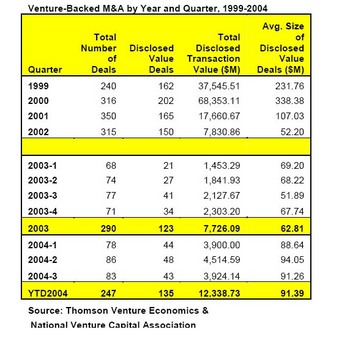Robert Scoble has asked the VCs to respond to an eWeek article titled Is .Net Failing to Draw Venture Capital Loyalty?. There is not much for me to add to this article as we all know that the only loyalty VCs have is to their Limited Partners to generate long-term capital gains. This means we do not fund a company because of what technology platform it chooses to develop on but rather what problem the company and product is solving and how big that opportunity is. It reminds me of a panel that I spoke on in 1997 at the Red Herring Java Technology Conference. The moderator asked me what types of Java companies we were interested in and my reply was that we do not look for Java companies, but rather solid management teams that are solving large problems in innovative ways. If Java happens to be the right technology platform to use, then so be it. Nothing has changed since then. As Brad Silverberg from Ignition rightly says in the eWeek article, "We’re technology agnostic here at Ignition."
To that end, let me talk about .Net. I have spent time over the last few years with .Net evangelists and they have been helpful in certain situations. That being said, most of the fund’s portfolio companies (90%+) are not using a .Net platform. When I dig deeper into technology and platform decisions, I like to think in 2 separate buckets, the consumer market and the enterprise market. On the consumer side, one big value for Microsoft has been its hold on the desktop as Tim Oren strongly points out, but as we move more and more into a web-based world its strength is diminishing. Look at Google, Firefox and new scripting services like Greasemonkey and Yubnub which are increasingly offering users more and more functionality through a web-based interface. I am sure Microsoft will get it right with Longhorn but it has taken way too long and many a more nimble, startup has out-innovated Microsoft and decreased its competitive advantage. While the OS is important, Microsoft has lost its complete and utter dominance as we move to a service-oriented world where broadband is everywhere, apps are in the cloud, and the browser becomes king. All that being said, I will not make my decision to fund a startup based on whether or not it uses .Net. For example, if you want to see a great app built on .Net go to a friend’s web service, Phanfare, and try using the application.
On the enterprise side, the only reason I would support having a company move off an existing platform to .Net is if there was significant customer demand for it and if Microsoft would really provide the company with access to its channel. Microsoft has been putting a huge effort in promoting their go-to-market support for startups but the irony is that Microsoft really wants companies to develop vertical, industry-specific applications on the .Net architecture. In other words, many of these companies are nice businesses but not venture-backable opportunities where VCs can make big returns. If Microsoft can change this attitude and show me where and how to make money leveraging its Ecosystem and partners, I am all ears. In the end VCs have be loyal to its Limited Partners, not a technology platform, so the eWeek article itself is overblown.
